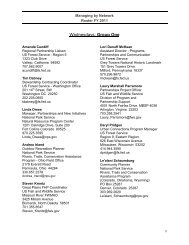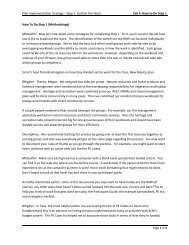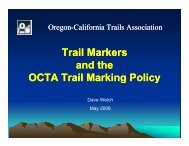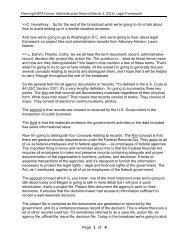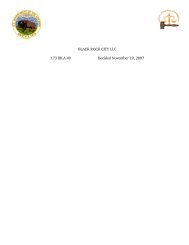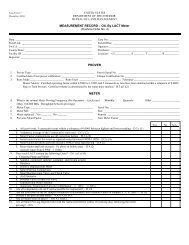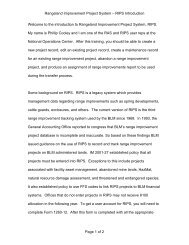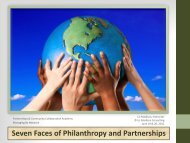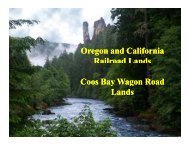<strong>BLM</strong> • A <strong>Desk</strong> <strong>Guide</strong> <strong>to</strong> <strong>Cooperating</strong> <strong>Agency</strong> <strong>Relationships</strong> and Coordination with Intergovernmental Partners • 20122• Enhancing local credibility of plans andenvironmental impact statements (EISs)• Encouraging CA support for managementdecisions• Building relationships of trust andcooperation• Making better, more informed decisionsThe CA role derives from the <strong>National</strong>Environmental Policy Act of 1969, which callson Federal, State, and local governments<strong>to</strong> cooperate with the goal of achieving“productive harmony” between humans andtheir environment (42 U.S.C. 4321–4347). Theregulations of the Council on EnvironmentalQuality (CEQ) that implement NEPA (40 CFRParts 1500–1508) allow Federal agencies—as lead agencies—<strong>to</strong> invite State, local, andtribal governments, as well as other Federalagencies, <strong>to</strong> serve as CAs in the preparation ofEISs.Additionally, in accordance with the FederalLand Policy and Management Act (FLPMA)of 1976, in the development and revision ofland use plans, the <strong>BLM</strong> has an independentresponsibility <strong>to</strong> coordinate with other units ofgovernment (43 U.S.C. 1712(c)(9)). As stated,the <strong>BLM</strong> will, <strong>to</strong> the extent practicable, seek<strong>to</strong> maximize consistency with the plans andpolicies of other government entities, whetheror not a CA relationship has been established.The <strong>National</strong> EnvironmentalPolicy Act…it is the continuing policy of the FederalGovernment, in cooperation with State andlocal governments, and other concernedpublic and private organizations … <strong>to</strong> createand maintain conditions under which manand nature can exist in productive harmony,and fulfill the social, economic, and otherrequirements of present and future generationsof Americans (42 U.S.C. 4331(a), emphasisadded).A CA relationship, however, provides anexcellent opportunity <strong>to</strong> meet the coordinationresponsibilities under FLPMA. This <strong>Guide</strong> willclarify the distinctions between a cooperatingagency relationship and the coordination thatthe <strong>BLM</strong> undertakes in carrying out FLPMA.The <strong>BLM</strong> amended its planning regulations in2005 <strong>to</strong> ensure that it engages its governmentpartners consistently and effectively throughthe CA relationship whenever land useplans are prepared or revised. In 2008 theDepartment of the Interior (DOI) applied thispolicy <strong>to</strong> the preparation of all EISs. TheCEQ and the DOI have also affi rmed that theCA relationship may be used for preparationof environmental assessments (EAs). CEQMemorandum on <strong>Cooperating</strong> <strong>Agency</strong> Reports,May 26, 2006; 43 CFR 46.225(e).The Challenges of FederalLand ManagementThe <strong>BLM</strong> has a large and complexresponsibility—managing more than 245million acres of America’s public lands androughly 700 million acres of its subsurfacemineral estate. More than 140 resourcemanagement plans authorize and guide everyaction and approved use of these lands andresources. The <strong>BLM</strong>’s plans encompassa highly varied terrain, from Alaska’s NorthSlope and California’s Mojave Desert, <strong>to</strong> theopen space surrounding many rapidly growingwestern cities. The agency’s challengeis <strong>to</strong> manage this portfolio on behalf of allAmericans, while recognizing the considerablelocal and regional consequences its decisionsmay have. The <strong>BLM</strong> must act in compliancewith Federal laws, regulations, and policieswhile seeking consistency with local andregional laws, policies, plans, needs, andvalues. This <strong>Guide</strong> represents a major step<strong>to</strong>ward meeting these challenges by ensuringthat the agency’s decisions benefi t from thevaried skills and knowledge of the <strong>BLM</strong>’sgovernment partners, including knowledge oflocal conditions and values.
In any Federal undertaking, harmonizingnational, regional, and local governanceentails at least three key tasks. As MatthewMcKinney and William Harmon noted in TheWestern Confl uence: A <strong>Guide</strong> <strong>to</strong> GoverningNatural Resources (2004), these includeintegrating the involvement of multiple partieswith competing interests and values, removingobstacles <strong>to</strong> sharing and validating relevantinformation, and resolving confl icts amonginstitutions and policies.• Multiple Parties. State, local, and tribalgovernment offi cials are often in a betterposition than are Federal land managers<strong>to</strong> engage the communities and interestgroups most likely <strong>to</strong> be affected by a planor proposed activity.• Complex Information. Effectivediscussion between Federal agenciesand the public is often blocked by deeplyincompatible views of the “facts” regardingcurrent environmental and socioeconomicconditions as well as the effects that aproposed plan or activity may have onthese conditions. Resolution of theseincompatibilities often requires the leadagency and CA partners <strong>to</strong> engage injoint factfi nding and <strong>to</strong> seek agreement onwhere <strong>to</strong> fi nd valid information and how <strong>to</strong>interpret it.• Conflicting Policies and Institutions.The challenge of managing public landscan reveal signifi cant disagreementsin jurisdictions and mandates, not onlyamong Federal, State, local, and tribalgovernments but also among differentFederal or State agencies. The CArelationship offers a forum in which <strong>to</strong>discuss and, if possible, reconcile divergentpolicies and plans for the common good.Although challenging, intergovernmentalcooperation in the management of lands andresources can yield great benefi ts for thepublic. The CA relationship is one <strong>to</strong>ol amongmany that can advance collective effortsamong government partners. Each partymay have some lessons <strong>to</strong> learn—and somepractices <strong>to</strong> unlearn.Common Characteristics ofWestern Resource DisputesMultiple Parties• Clash of values• Competing interests• Complicated relationships• Varying types and levels of powerComplex Information• Lack of information• Misinformation• Different views on what information isrelevant• Different procedures <strong>to</strong> collect and assessdata• Different interpretation of data• Different levels of comfort with risk anduncertaintyA Briar Patch of Policies and Institutions• Multiple jurisdictions• Competing missions and mandates• Lack of meaningful public participation• Multiple opportunities for appeal• A fundamental question of who shoulddecideFrom The Western Confluence: A <strong>Guide</strong> <strong>to</strong>Governing Natural Resources, by MatthewMcKinney and William Harmon. Copyright2004 by the authors. Reproduced bypermission of Island Press, Washing<strong>to</strong>n, DC.Experience has shown that there are threeprimary lessons that can lead <strong>to</strong> success whenworking across government boundaries. Theyare:1. Federal, State, local, and tribal partnersneed <strong>to</strong> recognize that the CA relationshipis a forum for sharing information andexpertise, not for asserting authority.Engaging in a CA relationship neitheraugments nor diminishes an entity’sSection 1. Introduction3




